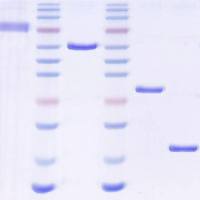Reconstitution of Active and Stoichiometric Multisubunit Lysine Acetyltransferase Complexes in Insect Cells
互联网
396
Protein lysine acetyltransferases (KATs) catalyze acetylation of the ε-amino group on a specific lysine residue, and this posttranslational modification is important for regulating the function and activities of thousands of proteins in diverse organisms from bacteria to humans. Interestingly, many known KATs exist in multisubunit complexes and complex formation is important for their proper structure, function, and regulation. Thus, it is necessary to reconstitute enzymatically active complexes for studying the relationship between subunits and determining structures of the complexes. Due to inherent limitations of bacterial and mammalian expression systems, baculovirus-mediated protein expression in insect cells has proven useful for assembling such multisubunit complexes. Related to this, we have adopted such an approach for reconstituting active tetrameric complexes of mo nocytic leukemia z inc (MOZ, finger protein, recently renamed MYST3 or KAT6A) and MO Z-r elated f actor (MORF, also known as MYST4 or KAT6B), two KATs directly linked to development of leukemia and self-renewal of stem cells. Herein, we use these complexes as examples to describe the related procedures. Similar methods have been used for reconstituting active complexes of histone deacetylases, lysine demethylases, and ubiquitin ligases, so this simple approach can be adapted for molecular dissection of various multisubunit complexes.









